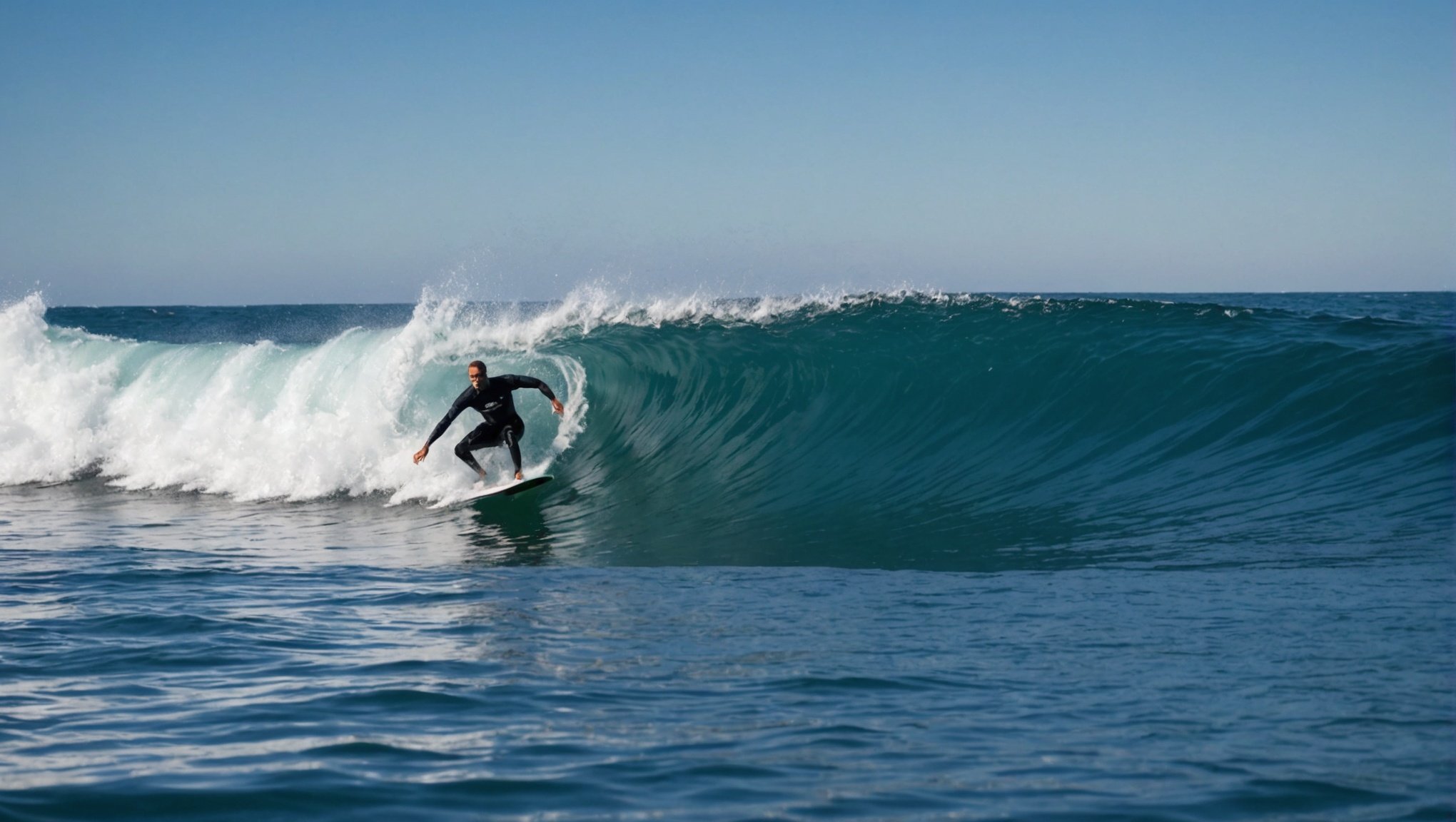Mastering the Waves: Strategies for Professional Surfers to Adapt Their Techniques to Varying Ocean Conditions
Surfing is an art that requires a deep understanding of the ocean and its ever-changing conditions. For professional surfers, adapting to these variations is crucial for maintaining peak performance and staying safe in the water. Here’s a comprehensive guide on how to master the waves in diverse ocean conditions.
Understanding Wave Formation and Types
Before diving into the strategies for adapting to varying ocean conditions, it’s essential to understand the basics of wave formation and the different types of waves.
Also read : Discover stunning vintage tennis posters for every fan
Wave Formation
Waves are generated by wind as it travels across the ocean surface, creating energy that moves in a forward direction. The wind direction, swell patterns, and the distance over which the wind blows (known as the fetch) all play significant roles in determining the characteristics of the waves[1].
Identifying Different Types of Waves
Waves come in various shapes and sizes, each presenting unique opportunities and challenges for surfers. Here are some common types of waves:
Additional reading : Discover your perfect pistol gel blaster for every game
- Beach Breaks: These waves break over sandy bottoms and can be found at most beaches. They are ideal for beginners but can also offer challenging conditions for experienced surfers.
- Point Breaks: These waves break over rocky or coral reefs and are known for their long, rolling waves. They are often favored by experienced surfers.
- Reef Breaks: These waves break over coral reefs and can be very powerful and fast.
- Rivermouth Breaks: These waves form where a river meets the ocean and can offer a mix of wave types.
Understanding these different types of waves is key to adapting your surfing technique to various ocean conditions[1].
Observing the Ocean and Reading Waves
Observing the ocean and learning to read waves are critical skills for any surfer, especially in varying conditions.
Observational Practice
Spending time observing the ocean before you surf is one of the best ways to learn how to read waves. Stand on the shore and note how waves approach the beach, how they break, and where the whitewater forms. Look for patterns in the swell and note any changes in the water’s surface. This practice helps you develop an intuition about the ocean’s mood and predict how waves will behave[1].
Reading the Break
Understanding where and how a wave will break is crucial. Waves can break steeply or roll gently, and positioning yourself correctly based on how the wave is breaking is essential. Focus on the lineup and observe the peaks where waves are likely to break. This skill is honed through practice and feedback from instructors during surf lessons[1].
Adapting to Different Ocean Conditions
Ocean conditions can vary significantly, and professional surfers need to be able to adapt their techniques accordingly.
Wind and Swell Patterns
Wind direction and swell patterns are key factors in determining wave characteristics. For example, in San Diego, where coastal conditions can vary, knowing the wind direction and swell patterns helps surfers anticipate how waves will break. A strong offshore wind can create cleaner, more organized waves, while an onshore wind can make waves choppy and difficult to ride[1].
Tides and Water Levels
Tides and water levels also impact wave behavior. For instance, a low tide can expose more reef or rock, making waves break more steeply, while a high tide can make waves break more gently. Understanding these changes is vital for selecting the right surf spots and adjusting your technique[4].
Water Temperature and Currents
Water temperature and currents can also affect surfing performance. Cold water, for example, can make your muscles stiffer, requiring you to warm up more thoroughly before surfing. Currents, whether they are rip currents or longshore currents, can affect your positioning and paddling techniques. Knowing how to read and navigate these currents is essential for maintaining balance and catching waves effectively[2].
Paddling Techniques and Timing
Paddling is a critical component of surfing, and adapting your paddling techniques to varying ocean conditions is crucial.
Timing Your Paddling
Timing is everything when it comes to catching waves. Knowing when to paddle can make the difference between catching a wave and missing it entirely. Pay attention to the wave’s speed and energy; a well-timed paddle will set you up for a successful ride. Instructors at surf schools emphasize the importance of positioning yourself correctly and timing your paddling to match the wave’s approach[1].
Adjusting Paddling Speed
The speed at which you paddle must be adjusted based on the wave’s speed and your body position. For faster waves, you may need to paddle more aggressively, while slower waves may require a more gentle approach. Here are some tips for adjusting your paddling speed:
- For Fast Waves: Paddle with more power and speed to match the wave’s energy.
- For Slow Waves: Paddle with a smoother, more consistent stroke to avoid overpowering the wave.
- In Strong Currents: Adjust your paddling angle to compensate for the current’s direction and speed.
Maintaining Balance and Control
Maintaining balance and control on the surfboard is essential, especially in varying ocean conditions.
Kneeling vs. Standing
The decision to kneel or stand on the surfboard depends on the wave type and your personal preference. For beginners, kneeling can provide more stability, while experienced surfers often prefer standing for better control and performance. Here’s a comparison of the two:
| Technique | Advantages | Disadvantages |
|---|---|---|
| Kneeling | More stability, easier to balance | Limited control, slower response |
| Standing | Better control, faster response | Requires more balance and practice |
Body Positioning
Your body positioning on the surfboard is critical for maintaining balance. Here are some key points to consider:
- Center of Gravity: Keep your center of gravity low and centered over the board.
- Weight Distribution: Distribute your weight evenly, with your feet shoulder-width apart.
- Flexibility: Keep your knees bent and your body flexible to absorb the wave’s movements.
Learning and Improving
Learning to surf and improving your skills is a continuous process, especially when adapting to varying ocean conditions.
Surf Lessons and Feedback
Taking surf lessons from experienced instructors can provide valuable feedback and help you improve your technique. Here are some benefits of surf lessons:
- Personalized Feedback: Instructors can provide specific tips on how to enhance your wave-reading skills and paddling techniques.
- Practice with Guidance: Practicing with an instructor helps you refine your technique and build confidence in the water.
- Safety: Instructors can teach you how to navigate different ocean conditions safely.
Embracing the Journey
Learning to surf is a journey that requires patience, dedication, and a willingness to learn. Here’s what Doug Silva, a renowned surf coach, has to say about the learning process:
“Surfing is not just about catching waves; it’s about understanding the ocean and respecting its power. The journey to mastering the waves is long, but it’s incredibly rewarding. Embrace every moment, whether you’re in the water or observing from the shore, and you’ll find that your surfing skills will improve significantly over time.”[3]
Practical Insights and Actionable Advice
Here are some practical insights and actionable advice for professional surfers looking to adapt their techniques to varying ocean conditions:
Read and Listen
- Read the Ocean: Spend time observing the ocean to understand wave patterns and anticipate how waves will break.
- Listen to Feedback: Take feedback from instructors seriously and use it to refine your technique.
Practice in Different Conditions
- Surf in Various Spots: Surf in different locations to experience a range of wave types and conditions.
- Surf at Different Times: Surf during different tides and times of day to understand how these changes affect wave behavior.
Stay Flexible and Adaptable
- Adjust Your Technique: Be willing to adjust your paddling techniques, body positioning, and wave selection based on the conditions.
- Stay Alert: Always be alert to changes in the ocean conditions and adjust your strategy accordingly.
Mastering the waves in varying ocean conditions is a complex but rewarding challenge for professional surfers. By understanding wave formation, observing the ocean, adapting paddling techniques, maintaining balance and control, and continuously learning and improving, surfers can enhance their surfing performance and enjoy a safer, more fulfilling surfing experience.
Whether you’re surfing in the Pacific surf spots of San Diego or exploring new surf camps around the world, the key to success lies in your ability to read the ocean, adapt your technique, and maintain a deep respect for the power of the waves. With dedication and practice, you’ll soon be confidently riding waves in any condition, enjoying every moment of your surfing journey.











